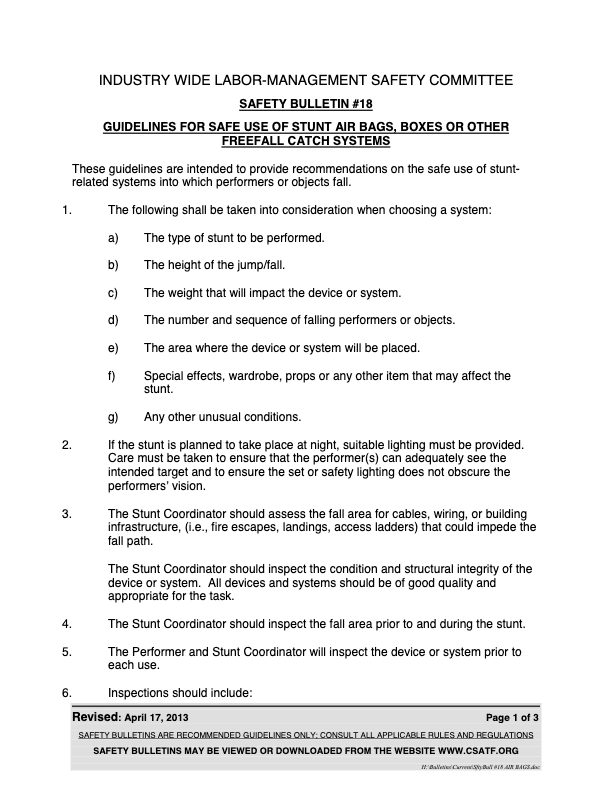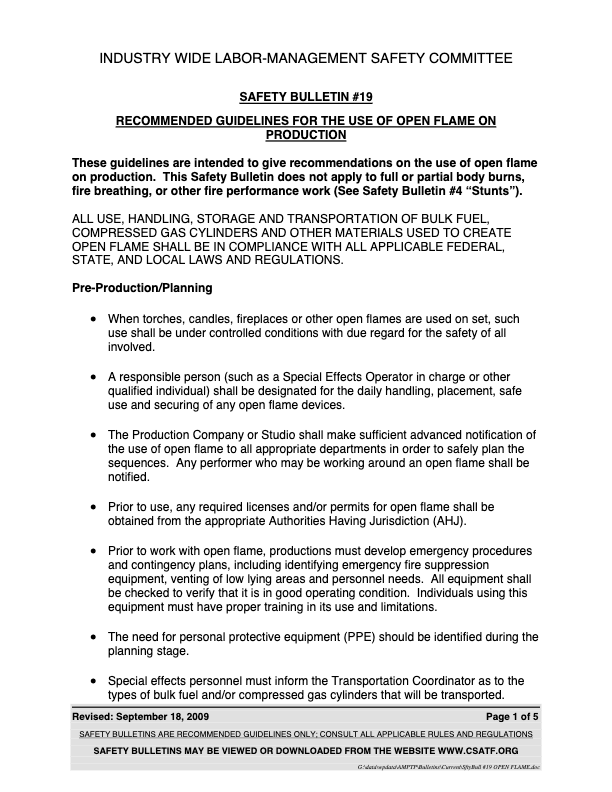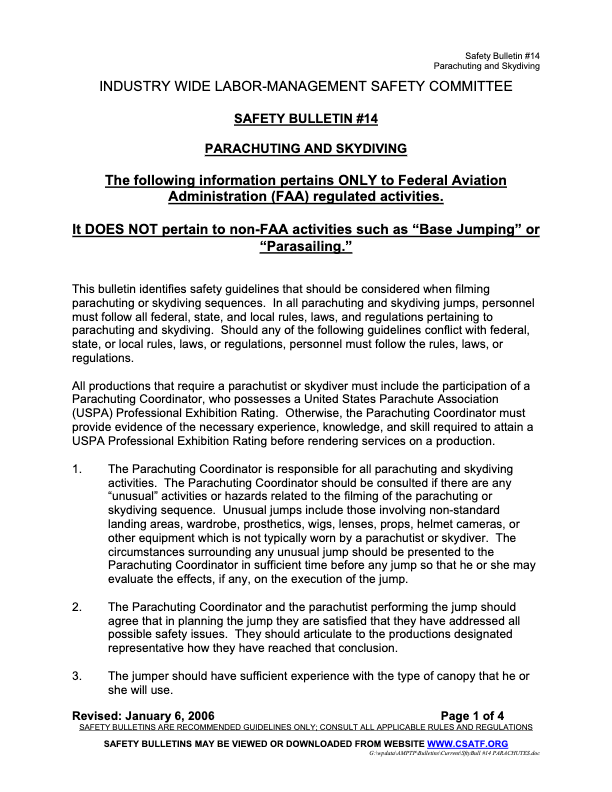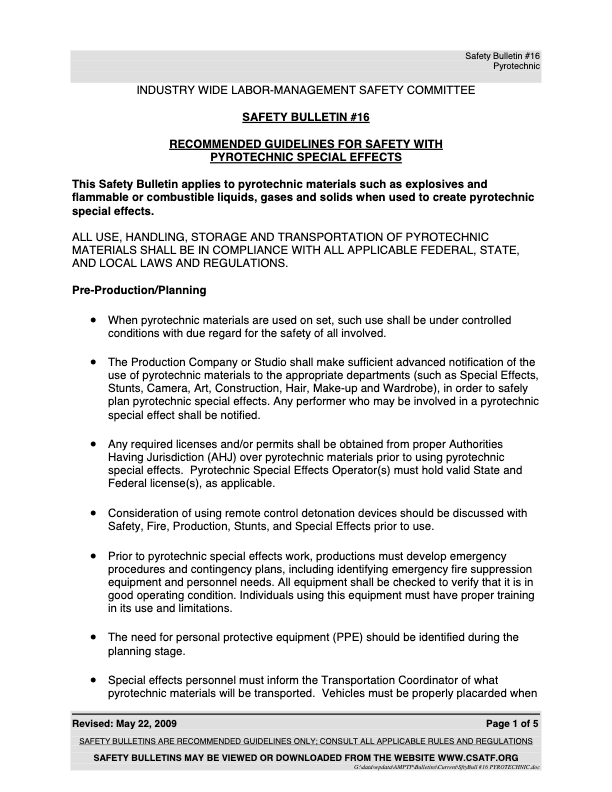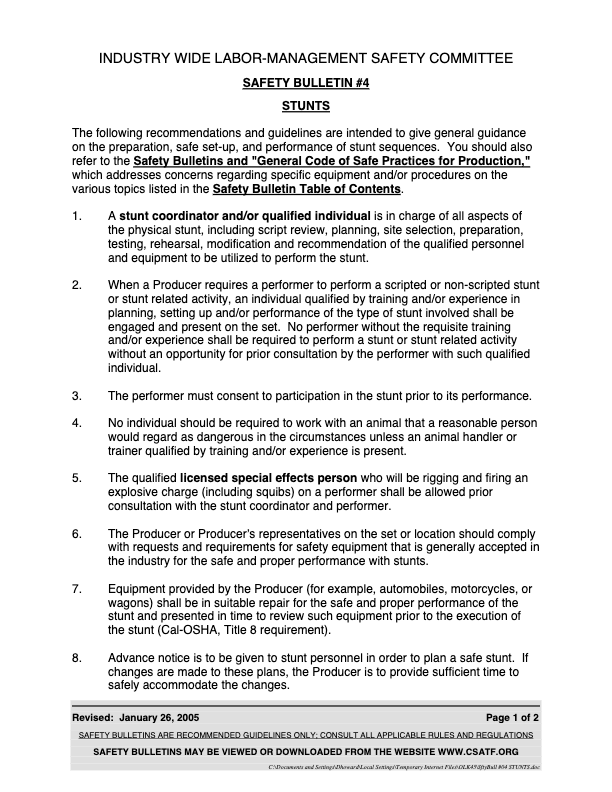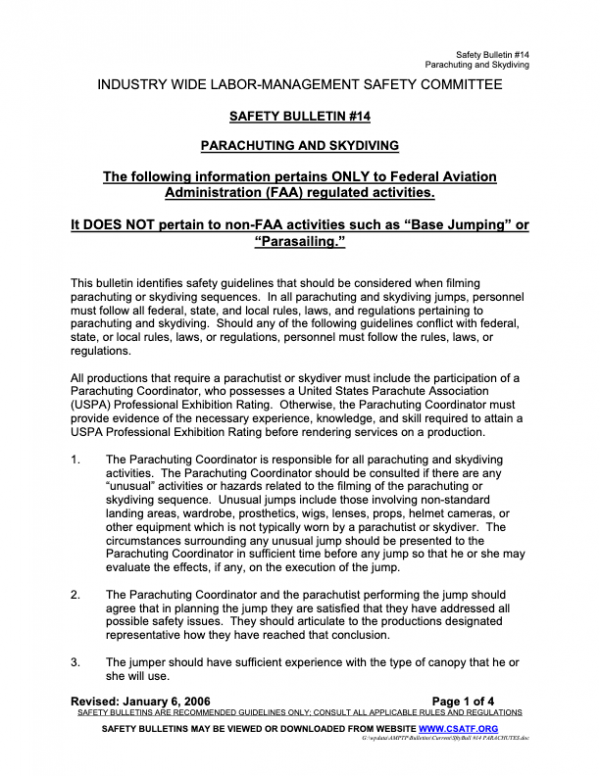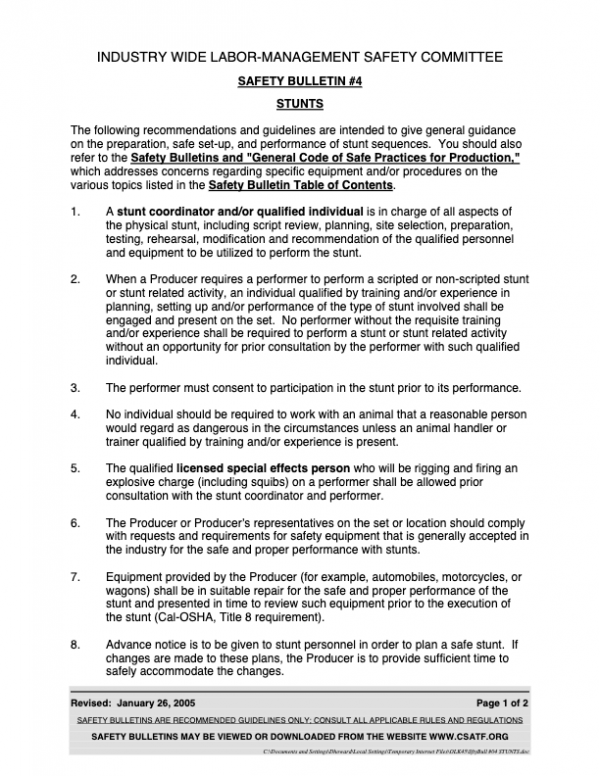Guidelines
The following information pertains only to Federal Aviation Administration (FAA) regulated activities. It does not pertain to non-FAA activities such as “Base Jumping” or “Parasailing.”
This bulletin identifies safety guidelines that should be considered when filming parachuting or skydiving sequences. In all parachuting and skydiving jumps, personnel must follow all federal, state, and local rules, laws, and regulations pertaining to parachuting and skydiving. Should any of the following guidelines conflict with federal, state, or local rules, laws, or regulations, personnel must follow the rules, laws, or regulations.
All productions that require a parachutist or skydiver must include the participation of a Parachuting Coordinator, who possesses a United States Parachute Association (USPA) Professional Exhibition Rating. Otherwise, the Parachuting Coordinator must provide evidence of the necessary experience, knowledge, and skill required to attain a USPA Professional Exhibition Rating before rendering services on a production.
- The Parachuting Coordinator is responsible for all parachuting and skydiving activities. The Parachuting Coordinator should be consulted if there are any “unusual” activities or hazards related to the filming of the parachuting or skydiving sequence. Unusual jumps include those involving non-standard landing areas, wardrobe, prosthetics, wigs, lenses, props, helmet cameras, or other equipment which is not typically worn by a parachutist or skydiver. The circumstances surrounding any unusual jump should be presented to the Parachuting Coordinator in sufficient time before any jump so that he or she may evaluate the effects, if any, on the execution of the jump.
- The Parachuting Coordinator and the parachutist performing the jump should agree that in planning the jump they are satisfied that they have addressed all possible safety issues. They should articulate to the productions designated representative how they have reached that conclusion.
- The jumper should have sufficient experience with the type of canopy that he or she will use.
- The Parachuting Coordinator and/or each individual parachutist must have authority over his or her jump, including the authority to abort a jump. Abort signals should be specified before starting the jump.
- The Parachuting Coordinator should designate a qualified person as a Ground Safety Contact, who should not have other responsibilities during the filming of the sequence that could interfere with his or her duties as the Ground Safety Contact.
- The Parachuting Coordinator, together with the Ground Safety Contact and any other designated production representative, should implement a plan for communications between the participants in the air and on the ground. This plan should incorporate the following equipment and actions to the fullest extent possible:
- Air to ground radios (VHF or FM) and any other effective means of communication.
- Assignment of discreet radio frequencies (channels).
- Visual signals (e.g., flags, specified hand signals, panels, lights or flares) to be used to, among other things, halt filming in the event of lost communications or inability to utilize radios.
- Abort signals (audible or visual) to be used to halt filming in the event of unforeseen circumstances or safety hazards.
- A pre-planned stunt sequence involving parachuting or skydiving should not be changed without the authorization of the Parachuting Coordinator. If the parachuting sequence involves special effects, the Special Effects Coordinator should also be consulted and both should agree on the proposed change(s). No changes should be made to a pre-planned stunt sequence once the stunt performers have departed the briefing area.
- Landings in public places must be restricted from the public. The Parachuting Coordinator should determine whether security personnel are necessary to exclude non-essential crew and non-participating spectators from the landing area.
- All flights and jumps must be conducted in accordance with Federal Aviation Regulations, Part 105, except variances that are outlined in a current FAA approved Motion Picture & Television Operations Manual and accompanying Waiver.
- The Parachuting Coordinator should determine whether the visibility, cloud ceiling height, and velocity of wind (as they apply to the particular situation) are safe for a jump and should take into consideration the landing area size, canopy type, number of jumpers and the planned stunt. In all circumstances, FAA rules regarding visibility and cloud clearance must be followed.
- Before each jump is performed, the Parachuting Coordinator should brief all persons involved with the on-site production and filming of the jump. He or she may include a “walk-thru,” simulation or “dry run” on the ground.
- The Parachuting Coordinator and jumpers should have the opportunity to inspect all landing sites before the jump during daylight hours, and again at night if a night landing is required. Jumps near or into potentially hazardous landing areas, (water, power lines, etc.) as determined by the Parachuting Coordinator, should be considered carefully.
- Before jump sequences, the Parachuting Coordinator or the designated production representative will conduct a SAFETY MEETING for the production staff and those persons necessary for filming, including emergency, safety and security personnel. Additional SAFETY MEETINGS may be required as necessary for intended action sequences or scenes. SAFETY MEETINGS may include discussion of the following:
- Pertinent jumping sequence, timing, landing zone, special considerations of the Parachuting Coordinator, or aerial coordinator, such as review of the Motion Picture and Television Operations Manual and accompanying Waiver, or any mandates by the local FAA Flight Standards District Office.
- Possible risk to personnel who are involved.
- Safeguards to personnel and equipment.
- Communication plan, including agreed upon visual and abort signals.
- Emergency procedures.
- Location of boundaries.
- Local governmental limitations or restrictions, if any.
- All equipment, props, wardrobe, etc., must be made available to the Parachuting Coordinator and the parachutist involved in the jump for evaluation before the jump. The Parachuting Coordinator should be consulted prior to establishing placement of any equipment, props, wardrobe, etc., that will be used in the jump. When necessary, this equipment, props, wardrobe, must be made available for test jumping or other practice.
- The Parachuting Coordinator may postpone or cancel the jump if at any time the safety of persons or property on the ground or in the air is in jeopardy, or if there is a contravention of the terms or conditions of any FAA Letter of Authorization, or any other applicable law, rule or regulation.
- A jumper may jump only with a main parachute packed by a “certificated parachute rigger,” or the jumper.
- All operations involving aircraft must conform to FAA regulations. All operations involving aircraft should also consider the Safety Bulletins on Helicopters, Fixed-Wing Aircraft, and Hot Air Balloons.
- All pilots involved in parachuting or skydiving sequences must be familiar and have experience with the dropping of jumpers. They should also be familiar with flights with the flight door removed, Federal Aviation Regulations, Part 105, and other applicable federal, state, and local laws, rules, and regulations. Before any jump, the pilot should know all ground signals and the agreed upon abort signal. He or she should be involved with rehearsals of aircraft exits, and should be familiar with any Letters of Authorization or waivers applicable to the jump. He or she should analyze the weight and balance of the aircraft with jumpers in exit position.
- Adequate watercraft and flotation gear must be available when the possibility of a water landing exists. Jumpers should consider wearing an approved self-inflating personal flotation device when a jump involves the possibility of a water landing.
- If the jump includes an intentional water landing, there should be one (1) boat per jumper with each containing an operator and safety personnel familiar with parachutes and water retrievals. The boat should be in the water with the engine running in sufficient time before jumpers exit the aircraft. Personal watercrafts are not recommended for retrieving jumpers with wet parachutes. All jumpers must wear an approved self-inflating personal flotation device when a jump involves a water landing.
- If the parachuting sequence involves a free-fall cinematographer, he or she should consult with the Parachuting Coordinator and both should agree on the “Plan of Activities”. Any free-fall cinematographer should be experienced with the type of camera equipment which will be used in the filming of the jump.
